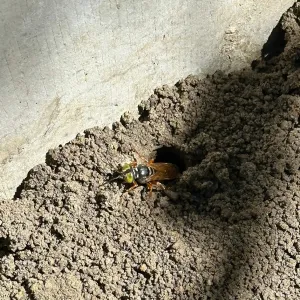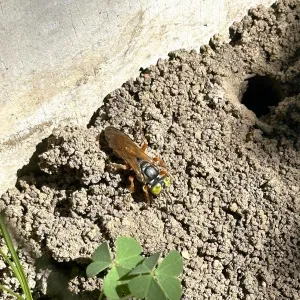Blog by Melinda Nestlerode
Everyone has a horror story to tell about wasps. When I mentioned that I was writing a blog about wasps to a friend, he launched into a tale about accidentally digging up a nest and then running for dear life. We all have stories of ruined picnics, encounters with wasps nests, and aggressive yellowjackets, who seem to enjoy tormenting us simply for existing in their territory.
My story is about a kinder, gentler type of wasp, although grasshoppers may not agree with me. The Tachytes distinctus, or green-eyed wasp, is considered a beneficial insect. Females hunt grasshoppers and katydids, which can be plant-eating pests in gardens. They are solitary, ground-nesting wasps, and not aggressive toward people. Adult green-eyed wasps feed on nectar, therefore qualifying as pollinator insects.
I noticed the presence of green-eyed wasps in my yard before I actually saw the insect. I saw small mounds of dirt with a hole in the center at the base of my concrete raised garden beds. The beds are fed by a drip system, and the bare earth surrounding them is more friable than most of the hard-packed midsummer clay soil nearby. Eventually, I saw a huge insect flying into and out of the holes. The female of this species is quite large, between 16mm – 18mm, while the males range between 14mm – 16mm. More startling than their size are their stunning green eyes.

Tachytes distinctus is native to North America. The females nest underground, usually in sandy soil. They often find existing cavities made by other insects or small animals, and begin their excavation from inside those holes. The females dig a long, shallow shaft, approximately 7 cm deep, and from 7 cm to 1 meter long. They provision individual cells in the shaft with juvenile grasshoppers, which they have paralyzed with their stinger. Each cell contains between one to thirteen grasshoppers, with an egg deposited on top of the last victim, and the cell sealed off with plant material. The egg hatches, and the larvae feed on the grasshoppers inside. They eventually pupate and emerge as an adult the following year.

This story about beneficial, pollinating wasps may end as a tragedy. As a part of our overall backyard plan, we intend to place landscape fabric and small stones around the raised beds. If we do this, the green-eyed wasps sealed underground will be trapped – entombed in their nursery. I’m not sure I have the heart to do this, after watching their mother work so hard to establish and provision the nest. Perhaps we can leave a narrow border around the raised beds for the next generation?
Thumbnail photo by Mary Keim on Flickr

